  At center from left, EM Principal Deputy Assistant Secretary Jeff Avery, U.S. Deputy Energy Secretary David Turk and Office of Legacy Management Deputy Director Scott Whiteford tour the Moab Uranium Mill Tailings Remedial Action Project last week with team members from the site.
MOAB, Utah — U.S. Deputy Energy Secretary David Turk and other DOE leaders joined community members and other stakeholders last week to mark the attainment of an EM 2023 priority at the Moab Uranium Mill Tailings Remedial Action (UMTRA) Project earlier this year.
In October, the Moab Project team successfully relocated another 1 million tons of uranium mill tailings away from the Colorado River, bringing the cumulative total to 14 million tons permanently removed.
“The Moab site is a great example of coming together — federal, state and citizen groups — to not only execute a cleanup mission, but to partner and create a vision for what this land can become,” Turk said.
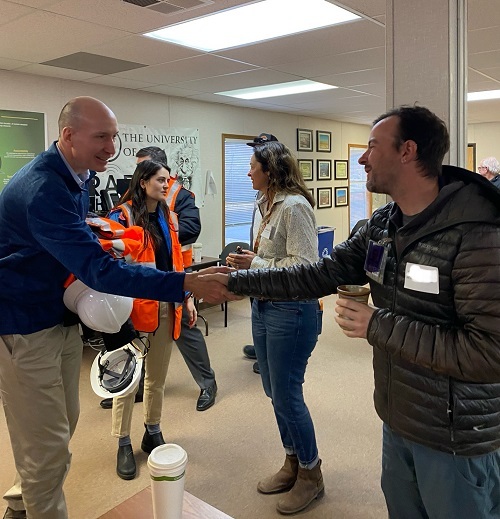 |
|
U.S. Deputy Energy Secretary David Turk thanks a Moab Uranium Mill Tailings Remedial Action Project team member. |
About 2 million tons of the contaminated soil and debris remain to be disposed of in an engineered disposal cell in Crescent Junction, 30 miles north of the Moab site. The material resulted from legacy uranium milling operations.
“I’m pleased that our team here continues to draw down the mill tailings, protecting the beautiful Colorado River and the Moab community,” Turk added.
Removing the mill tailings from the Moab site is a priority within EM’s 10-year Strategic Vision.
“Every year the Moab UMTRA team works through numerous challenges to advance EM’s cleanup and closure mission at Moab. This year is no different,” Moab Project Acting Federal Cleanup Director Matthew Udovitsch said. “Reaching 14 million tons put us another step closer to executing EM’s mission at Moab.”
 EM Principal Deputy Assistant Secretary Jeff Avery thanked the Moab Project’s dedicated team, the Moab community, agency partners and project stakeholders for helping EM reach the milestone ahead of schedule.
“It is exciting to see years of community and project work get so close to completion,” he said.
“We are here for the long haul,”
-DOE Office of Legacy Management Deputy Director Scott Whiteford
Prior to the ceremony, Turk, Avery and other Department leaders were joined by DOE Office of Legacy Management (LM) Deputy Director Scott Whiteford and LM staff for a site tour.
Upon completion of EM’s Moab Project cleanup, LM will partner with the community to determine an end state for the site, and work with the community to plan for reuse and its future.
“We look forward to working with you, the state and tribal partners, and transitioning this great site to making it beneficial for the community,” Whiteford said to an audience of 50 guests. “We are here for the long haul.”
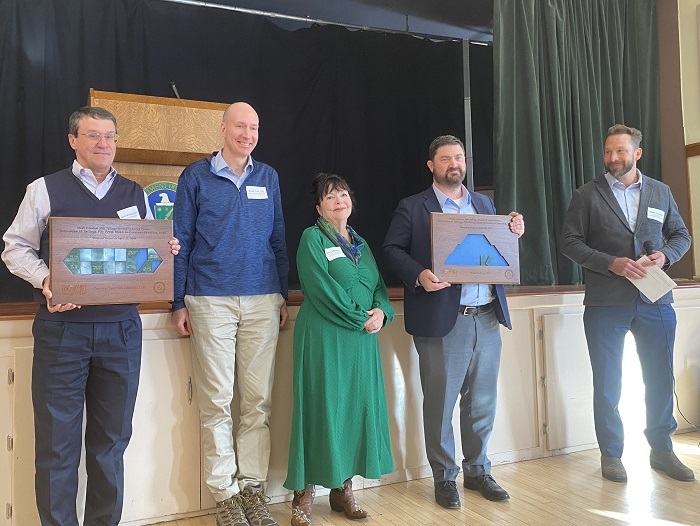 Officials are pictured with the Moab Uranium Mill Tailings Remedial Action Project transfer plaques at a ceremony last week marking the relocation of another 1 million tons of uranium mill tailings away from the Colorado River. From left, Office of Legacy Management Deputy Director Scott Whiteford, U.S. Deputy Energy Secretary David Turk, Grand County Commission member Mary McGann, EM Principal Deputy Assistant Secretary Jeff Avery and Moab Project Acting Federal Cleanup Director Matthew Udovitsch.
Interested community members can inquire about planning for the site’s future at Moab Tailings Project Steering Committee meetings.
Mary McGann, committee chair and Grand County Commission member, joined Turk to move the “tile,” representing another 1 million ton of waste removed from the Moab site and shipped by rail to the Crescent Junction disposal location.
McGann explained how things have come “full circle” since her father worked at the Atlas mining company, which operated the Moab mill decades ago.
“He made the pile [of uranium tailings] and now I’m cleaning up the pile,” she said.
Uranium concentrate, known as “yellowcake,” the milling product, was sold to the U.S. Atomic Energy Commission, a predecessor agency to DOE, through December 1970 for use in national defense programs.
The ceremony concluded with a celebratory yellow cake for guests to enjoy.
-Contributor: Barbara Michel
  The Paducah Site checked off an EM 2023 priority by removing 1 million pounds of R-114 refrigerant from the site. The milestone shipment that led the site to achieve the priority is pictured here.
PADUCAH, Ky. — The Paducah Site recently met an EM 2023 priority ahead of schedule with the safe and successful disposal of over 1 million pounds of R-114 refrigerant, an environmental hazard stored at the site.
Removing that amount of R-114 refrigerant from the environment has an impact equal to reducing greenhouse gas emissions from taking about 10,000 vehicles off the road each year.
“For the third year, Paducah Site has risen to this million-mark challenge. Removing the R-114 from the Paducah Site will significantly reduce this legacy hazard,” Portsmouth/Paducah Project Office Manager Joel Bradburne said. “The steady progress made on the shipment of R-114 disposal at the Paducah Site is a testament to the project team’s focus and safety commitment.”
 Commonly known as Freon, R-114 played an important role in supporting uranium enrichment operations at EM’s Paducah Site before operations ceased in 2014. The site produced large quantities of heat as a result of compressing uranium hexafluoride gas. R-114 was pumped into the system to control temperatures during the conversion process.
Over half of the more than 8 million pounds of R-114 onsite has been shipped and disposed of while another 1 million pounds is planned to be shipped in 2024. Significant improvements, including upgrading shipment trailers and strategic partnerships with commercial incinerators, ensure the continued safe and compliant disposal of R-114 from the site.
“Our partnerships with industry leaders have been pivotal in meeting this milestone,” said Myrna Redfield, program manager with Four Rivers Nuclear Partnership, the deactivation and remediation contractor for the Paducah Site. “Agreements with our commercial partners to increase the amount of R-114 shipped from the site is key to meeting the disposition set by DOE.”
-Contributor: Dylan Nichols
 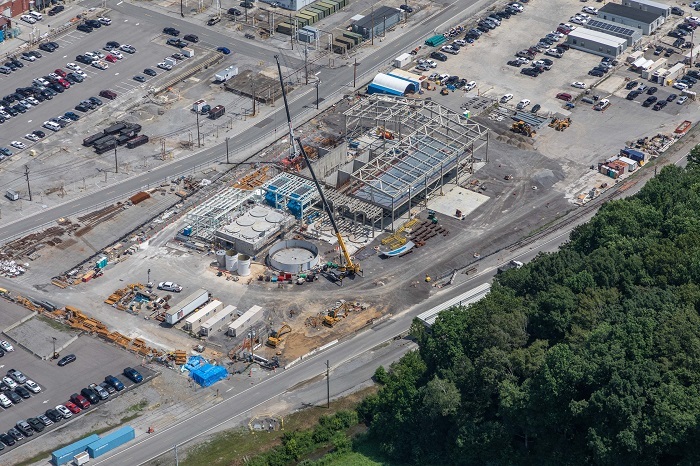 Construction progressed on the Mercury Treatment Facility at the Y-12 National Security Complex in 2023. This is a view of the treatment plant facility where crews are finishing the framework.
OAK RIDGE, Tenn. — DOE’s Oak Ridge Office of Environmental Management (OREM) logged another successful year, achieving all of its EM priorities for 2023 and advancing cleanup across the site.
OREM and cleanup contractor UCOR continued transforming Oak Ridge National Laboratory’s (ORNL) central campus by tearing down the Low Intensity Test Reactor. This project marked Oak Ridge’s second reactor demolition in the span of a year. Crews also removed part of the reactor vessel from the neighboring Oak Ridge Research Reactor, a key step forward in the facility’s deactivation.
These projects are clearing away high-risk buildings that have been shut down for decades and opening land ORNL can reuse to support future research missions.
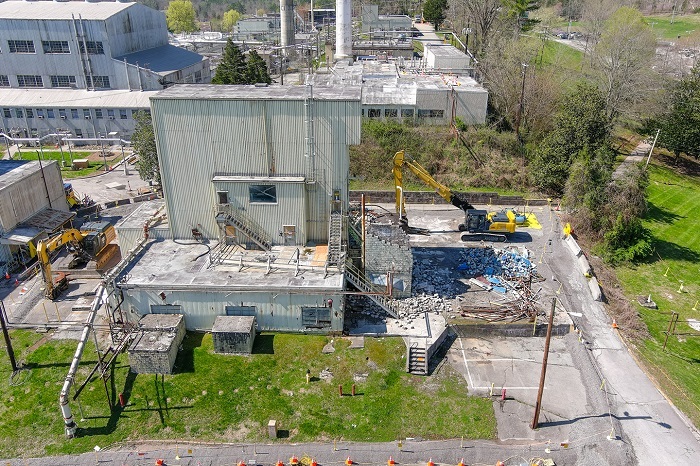 A view of demolition beginning on the Low Intensity Test Reactor. This project marked the second reactor demolished in the span of a year in Oak Ridge National Laboratory’s central campus area.
Crews were busy deactivating nearly a dozen other excess contaminated facilities at ORNL and the Y-12 National Security Complex (Y-12). These projects moved many structures closer to demolition, which enables future landscape changes at those sites.
Teams have prepared Y-12’s Alpha-2 facility, a former Manhattan Project uranium enrichment facility, for demolition next year. Some crews are busy deactivating the Beta-1 at Y-12, while others are deactivating the Isotope Row facilities, Building 3026 Hot Cell, and Graphite Reactor support facilities at ORNL
OREM is also steadily eliminating Oak Ridge’s inventory of nuclear waste. Processed transuranic waste is being steadily shipped to EM’s Waste Isolation Pilot Plant. Employees are downblending and disposing of the inventory of uranium-233 stored at ORNL. As part of an innovative public-private partnership, that project is also extracting medical isotopes that are supporting next generation cancer treatment research.
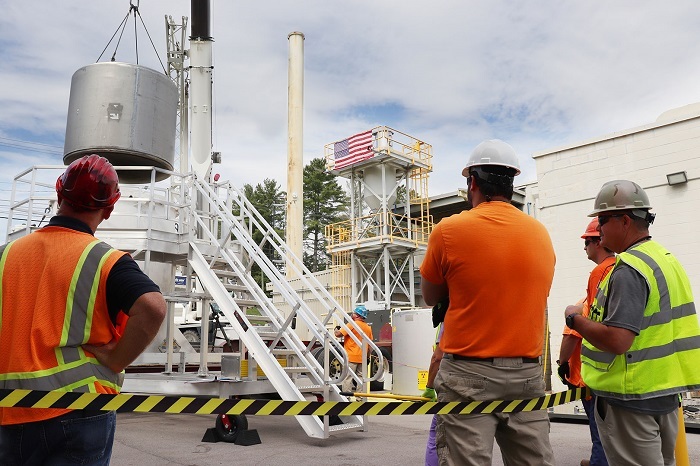 Employees load processed uranium-233 material that has been downblended into a form safe for transportation and disposal out of state.
Two crucial infrastructure projects moved forward in 2023. OREM broke ground on the Environmental Management Disposal Facility this summer. With the existing onsite disposal facility nearing full capacity, this project is essential to maintain cleanup momentum at ORNL and Y-12.
Construction also progressed on the Mercury Treatment Facility at Y-12. When operational, this plant allows OREM to begin addressing Y-12’s large, mercury-contaminated facilities and sources of mercury in the soil, thereby protecting against releases into a nearby creek. Teams are finishing the framework on the treatment plant, and they’ve completed the foundation on the plant’s headworks facility and begun major installations to it.
 Leaders gather in August to break ground on the Environmental Management Disposal Facility. With the current onsite disposal facility nearing full capacity, this project is essential to maintain cleanup momentum at Oak Ridge National Laboratory and the Y-12 National Security Complex.
OREM is nearing the end of its cleanup mission at the East Tennessee Technology Park (ETTP). With crews set to finish excavating contaminated soil from the site next year, the spotlight is now turning to groundwater — the last phase of cleanup there.
Planning took a major step forward in 2023 when the U.S. Environmental Protection Agency and Tennessee Department of Environment and Conservation approved proposed plans for addressing groundwater at ETTP. Those plans will help OREM chart its path to complete cleanup there and achieve its ultimate vision of transforming the site into a multi-use industrial center, national park and conservation area for the community.
-Contributor: Ben Williams
 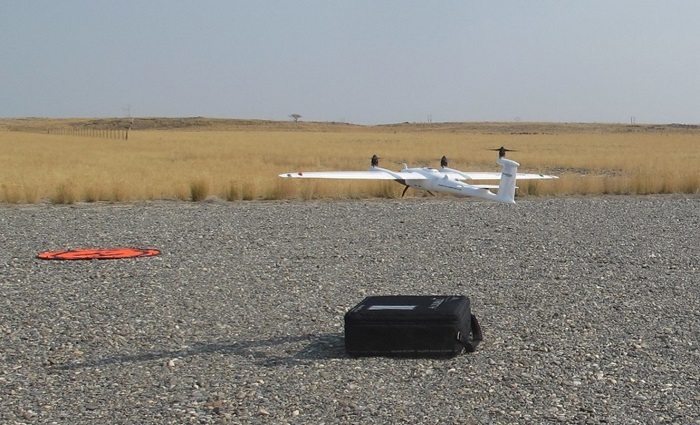 One of two drones EM acquired in 2020 for use at the Idaho National Laboratory Site takes flight. This drone specializes in aerial photography and remote sensing.
IDAHO FALLS, Idaho — EM’s use of aerial drones at the Idaho National Laboratory (INL) Site is enabling cleanup contractor Idaho Environmental Coalition (IEC) to collect valuable data, protect workers and reduce costs.
Between 2005 and 2019, crewed aerial flights and ground survey crews were the primary surveying tools for determining waste disposal project volumes, elevations and disposal heights of landfills. But contracting approved pilots and conducting ground surveys are costly and time intensive. The crewed flights alone cost EM around $20,000 a year.
To address these challenges, EM staff at the INL Site revolutionized their approach and introduced drones. In 2020, EM approved the purchase of two outdoor drones and created the Aerial Survey Drone Program.
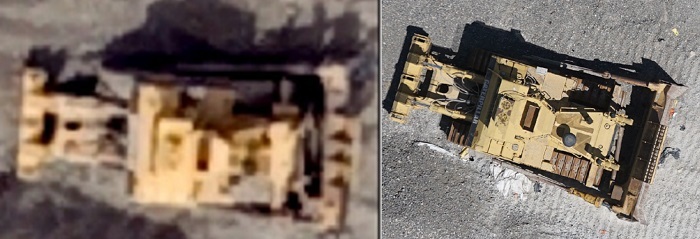 These images of a bulldozer at the Idaho Comprehensive Environmental Response, Compensation, and Liability Act Disposal Facility illustrate a difference in resolution between photographs taken by a crewed aerial survey and a drone. The drones not only produce sharper photographs, as shown in the image at right, they also capture more data used to generate highly detailed ground surface models.
The drones specialize in aerial photography, videography and remote sensing, which help produce photograph mosiacs with embedded geographic references, 3D digital terrain models, surface contours and thermal imagery.
The impact of the flexible, consistent and accurate data produced by an in-house drone pilot was immediate.
High quality data have proven beneficial for a project to expand a portion of an INL Site landfill known as the Idaho Comprehensive Environmental Response, Compensation, and Liability Act Disposal Facility (ICDF).
Remote drone pilots capture photographs over the ICDF, which are then used to generate orthomosaic photographs, contours and digital terrain models of the landfill. In turn, the project can demonstrate elevation and disposal heights, and calculate remaining volume in the existing landfill, and use this data to plan for future disposal placement locations. The data collected from aerial surveys will also document the construction progress for other projects, such as the new ICDF Cell 3 landfill.
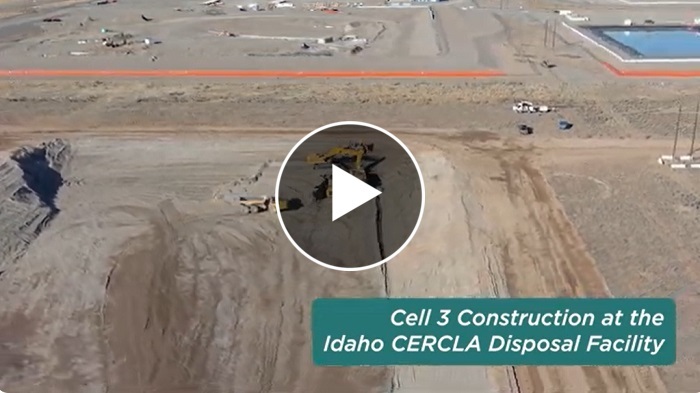 EMTV: EM’s use of aerial drones at the Idaho National Laboratory Site is enabling the Idaho Environmental Coalition to collect valuable data, protect workers and reduce costs.
Transitioning from ground crews to aerial surveys protects workers from potential hazards in the field. IEC’s Environmental Restoration Program is also exploring the possibility of using drones to monitor vegetation restoration and conduct inspections at the disposal site for the Stationary Low-Power Reactor Number One nuclear reactor.
Other EM construction projects at the INL Site are interested in capturing orthogonal photography. At the Radioactive Waste Management Complex’s Accelerated Retrieval Project, aerial surveys can help as the project prepares for the construction of a cap over the landfill known as the Subsurface Disposal Area.
While still in its infancy, the Aerial Survey Drone Program is exploring other opportunities to support projects at the INL Site.
"As the program gains momentum, there is cause for optimism," said Dan Mahnami, the remote drone pilot and geographic information system analyst for IEC. "IEC is at the forefront of innovative work that is already enhancing cleanup work."
-Contributor: Carter Harrison
 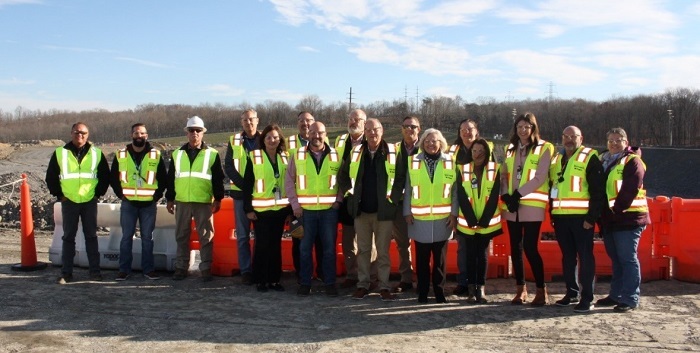 Paducah community leaders saw how the Portsmouth On-Site Waste Disposal Facility became a catalyst for advancing site cleanup and setting the stage for freeing up available land for reuse during their recent tour.
PIKE COUNTY, Ohio — Envisioning a future for EM sites can be challenging for communities given the longevity of cleanup activities. However, when two sites have an almost identical footprint — in this case Portsmouth in Ohio and Paducah in Kentucky — the opportunity to see potential becomes clearer.
In November, EM Portsmouth/Paducah Project Office (PPPO) Manager Joel Bradburne and Portsmouth Site Lead Jeremy Davis hosted community leaders from the Paducah area at the Portsmouth Site to observe how an integrated cleanup approach is freeing up federal land for the community to pursue economic development opportunities.
During a site tour that provided a view of current cleanup projects, Bradburne shared with community leaders the importance of a thoughtful cleanup strategy that begins with the end in mind.
“A sustainable economic development future for the site post-cleanup begins at the start of deactivation and demolition,” Bradburne noted. “In 2010, we began a holistic parallel path between future use and cleanup designed to quickly merge into one goal: safely clean up the site in a pattern that maximizes the potential for transferring excess federal land.”
In addition to the site tour, the groups visit included discussions on site reuse and stakeholder collaboration with future use partners Stephanie Howe from Ohio University and Kevin Shoemaker from the Southern Ohio Diversification Initiative, a community reuse organization.
“We are very appreciative of the time that everyone from Portsmouth spent with us. It was very educational and informative for us to see what you have going on,” said Paducah City Commissioner and Paducah Area Chamber of Commerce President Sandra Wilson. “As a PPPO partner, it’s important that we work together and have a thorough understanding about each other’s site and community.”
-Contributor: Cindi Remy
 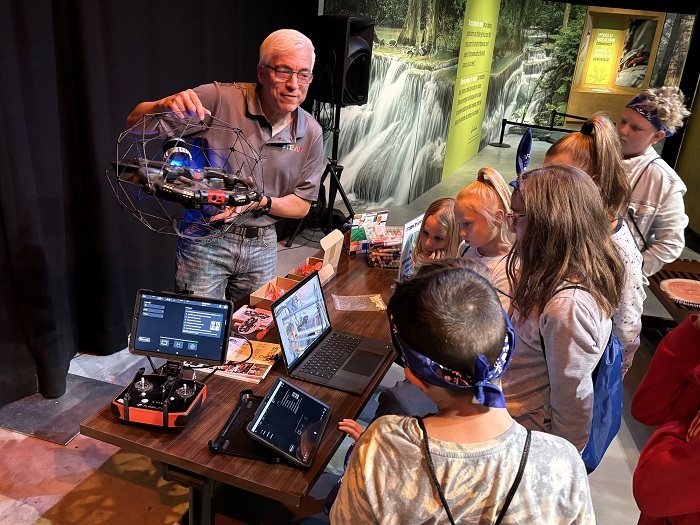 Kevin Young, weSTEAM founder and principal electrical engineer, interacts with students at the Museum of Idaho’s Night at the Museum STEAM activity.
IDAHO FALLS, Idaho — EM’s contractor at the Idaho National Laboratory (INL) Site took an important step in its efforts to support science, technology, engineering, arts and math (STEAM) education in Idaho with the formation of its weSTEAM program.
While the Idaho Environmental Coalition (IEC) program is new, its roots lie in EM’s longstanding STEAM outreach and focus on creating STEAM awareness in the community.
weSTEAM was formed to support science, teach technology, encourage engineering, associate art with science and magnify the importance of math to young people in Eastern Idaho.
Additionally, the program addresses a critical need in today’s market — filling the STEAM career gap. With an enormous need for people to fill technical and STEAM-based careers in the United States, IEC employees want to help Idaho’s budding minds to discover opportunities in STEAM education.
“There are a lot of employees here who would like to be able to give back to the community,” said Carl Gaufin, weSTEAM co-chair and a mechanical engineer with IEC’s engineering and design program. “weSTEAM serves as an organized gateway to doing this.”
 EMTV: Watch a video filmed during a weSTEAM training demonstration.
For years, EM technical staff at the INL Site have committed support to STEAM outreach initiatives in Idaho, including Earth Day and Engineering Day events at the Idaho Falls Zoo and presentations in local classrooms.
Now, weSTEAM offers training to helps volunteers channel their passion and become effective teachers of technical subjects. They can learn how to use creative demonstrations to draw the attention of young audiences and ignite interest in STEAM.
Gaufin says well trained volunteers not only help their audiences learn, but they also leave youth with lasting impressions that the STEAM career path is worth exploring.
At the Museum of Idaho’s recent Night at the Museum event, a STEAM learning activity for kids from the Greater Idaho Falls Area, trained weSTEAM volunteers taught kids about stored energy and some uses of drones. Volunteers helped the young students construct their own stored energy rubber band drones.
“It was great to see the students unleash their own potential energy as they built the drones and let them fly,” said Gaufin. “Several of them even had alternative ideas they were going to pursue with their drones. That to me is a successful night: when an idea is shared and it grows into something else.”
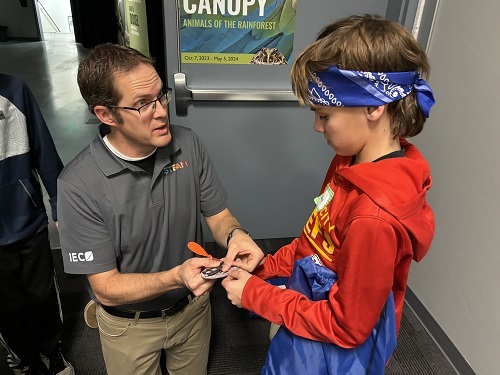 |
|
Carl Gaufin, a weSTEAM volunteer, helps a student construct a stored energy rubber band drone. |
EM crews have used drones to support their work, including a historic drone flight at the INL Site’s Calcine Disposition Project to collect valuable data from a safe but radiologically active storage facility.
Innovative minds breed innovative solutions. Looking to the future, programs like weSTEAM will play an important part in raising the next generation of innovators.
An intent of the program is to draw more people to science and engineering jobs through effective STEAM teaching.
As Gaufin sees it, weSTEAM is about building up young students to become the next generation of scientists and engineers while building up weSTEAM volunteers to become effective mentors and role models.
EM and IEC also support STEAM education in local schools through grants, which have been used to acquire robotics equipment, classroom science experiments, books and other supplies for local students.
-Contributor: Carter Harrison
 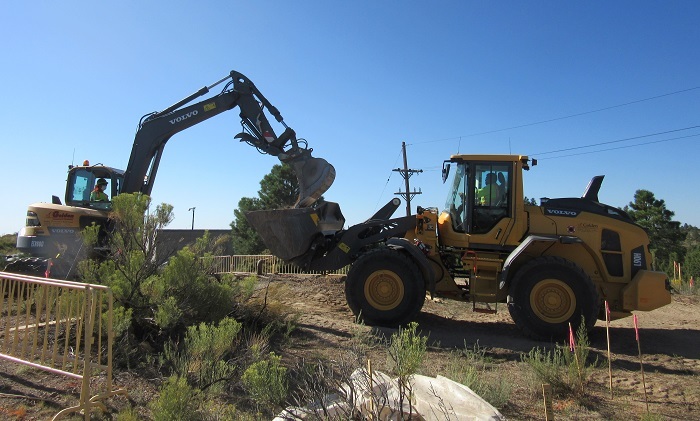 EM cleanup contractor Newport News Nuclear BWXT Los Alamos removes contaminated soil from legacy Los Alamos National Laboratory operations in North Ancho Canyon.
LOS ALAMOS, N.M. — The EM Los Alamos Field Office (EM-LA) and its legacy cleanup contractor at Los Alamos National Laboratory (LANL) are making steady progress in a key program central to the legacy cleanup mission.
Over the course of 2023, EM-LA and Newport News Nuclear BWXT Los Alamos (N3B) completed investigation and soil remediation at two “Aggregate Areas” — the Threemile and North Ancho canyons. Aggregate Areas are geographical areas within watersheds or canyons that contain soil and debris contaminated from legacy operations at LANL.
Aggregate Areas are grouped into eight campaigns under the 2016 Compliance Order on Consent. That order is an enforceable agreement between the New Mexico Environment Department (NMED) and DOE for the cleanup of legacy waste at LANL, and establishes a structure for accomplishing cleanup work on a priority basis through the use of campaigns. Threemile Canyon is included in the Pajarito Watershed Campaign, while North Ancho Canyon is included in the Southern External Boundary Campaign. EM-LA and N3B currently have six Aggregate Area campaigns in progress.
“Cleaning up the land is one of our major areas of focus in the legacy cleanup mission at LANL,” N3B Environmental Program Manager Troy Thomson said. “By cleaning up these Aggregate Areas, we’re characterizing and removing contamination from these legacy soil sites.”
There are 23 Aggregate Areas within the LANL site. In 2024, EM-LA and N3B will perform site characterization and remediation at five Aggregate Areas: Twomile, Starmer/Upper Pajarito, Chaquehui, Lower Pajarito and Potrillo/Fence Canyon.
Work at each Aggregate Area involves identifying the nature and extent of radiological and hazardous contamination, remediating the site if necessary, and then submitting investigation reports, including risk assessments, to NMED for approval.
Cleanup within an Aggregate Area is based on investigation and can range from no cleanup necessary, to removing a small amount of debris, such as a fuel tank, to performing extensive remediation of multiple sites with contaminated soil, debris and other materials.
-Contributor: Todd Nelson
 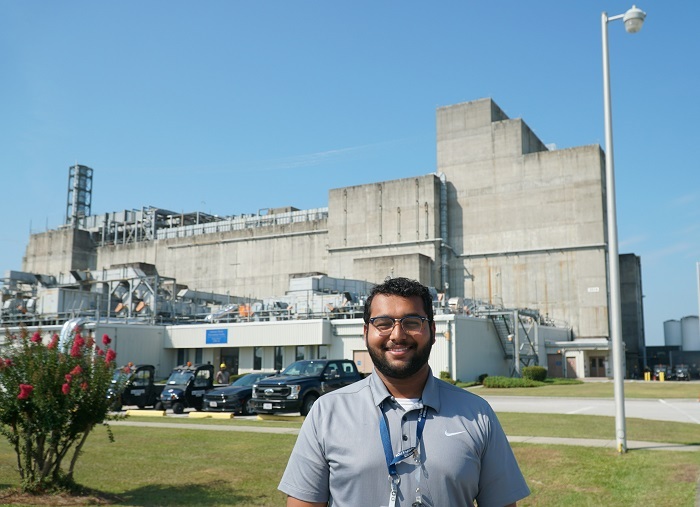 While interning with Savannah River Mission Completion, Texas Tech University rising senior Jinju Philip spent time in the quality assurance program inside the Defense Waste Processing Facility at the Savannah River Site. He now works part time in the Technical Student Program as a system engineer for the company’s tank closure effort.
AIKEN, S.C. – EM’s liquid waste contractor at the Savannah River Site (SRS) is giving nine college students the opportunity to jump-start their careers this year through a hybrid work program while finishing their engineering or computer science studies.
The Technical Student Program (TSP) gives rising senior summer interns with Savannah River Mission Completion (SRMC) the opportunity to continue working part time after returning to school in the fall. Students can choose to stay in the program until they graduate. Those who enter the program do so with the intention of eventually continuing their work with SRMC after graduation.
Completion of the TSP leads to attainment of technical staff qualifications, enabling engineers to become qualified design authorities with SRMC. Design authorities are able to propose and approve changes to systems within the SRS Liquid Waste Program. This also gives the new hires a promotion to an engineer position that is a step above an entry level role.
Since the program’s inception three years ago, 19 interns have entered the program to transition from school to work. Of that group, 18 were offered positions in the liquid waste program and are working for SRMC.
SRMC President and Program Manager Dave Olson said the program simplifies and streamlines the process of transitioning interns into new hires.
“Once their summer internship ends at SRS, those interns who perform extremely well on the job can be selected to remain employed with us to complete their training — even while finishing their college courses,” Olson said. “This program gives our extraordinary interns a clear path from their summer internship into their engineering career with us.”
SRMC’s success will always depend on the strength of the workforce, Olson noted.
“Each intern chosen for the program must exhibit positive attributes and aptitude,” he said. “We always strive for the highest levels of excellence when it comes to safety, training and building our incoming talent.”
Participants are reviewed by a screening board before receiving formal offers to participate. The TSP also provides mentoring opportunities from full-time employees who work directly with the students.
Jinju Philip, a mechanical engineering student at Texas Tech University, is taking part in the TSP this year. His focus is with tank closure of the site’s old-style tanks.
“This program offers a structured environment for honing my engineering skills, providing a solid foundation for transitioning into a full-time position,” Philip said. “What’s been particularly beneficial is the ongoing support from my manager and mentor. We have regular conversations every week. They provide valuable advice not only on excelling in my role but also on how to succeed in my academic pursuits and future career.”
-Contributor: Jim Beasley

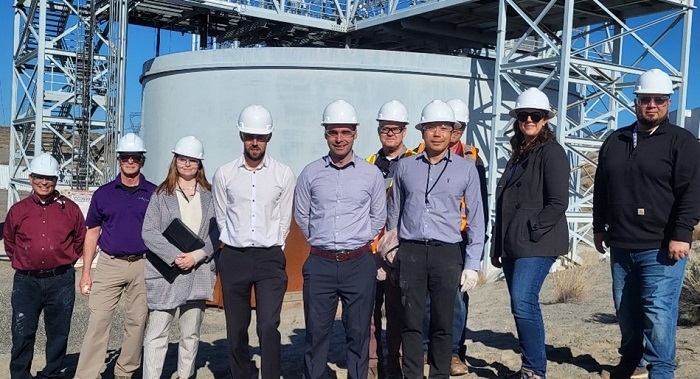 Teams from Hanford and the United Kingdom’s Sellafield Site exchanged information about ongoing cleanup missions at both sites during a recent visit to the Hanford Site. From left: Rick Raymond, a senior technical advisor with Central Plateau Cleanup Company; Kayle Boomer, Washington River Protection Solutions (WRPS) Technology Management and Field Solutions manager; Ashley Furman, a project support engineer with Longenecker and Associates; Ryan Clifford, a Sellafield Ltd. Site Ion Exchange Effluent Plant (SIXEP) technical advisor; Tom McMillan, a Sellafield Ltd. SIXEP technical lead; Mike Leonard, WRPS Tank Farm Projects Engineering and Chief Technology Office (CTO) manager; Sam Manalertsakul, Jacobs Clean Energy Ltd. process engineer; Mike Sutey, WRPS Retrievals Engineering manager; Amanda Hede, WRPS CTO senior project manager; and Alonso Rodriguez, a WRPS mechanical engineer.
RICHLAND, Wash. — Teams at EM’s Hanford Site recently welcomed a group of engineers from the United Kingdom’s Sellafield Site for a visit to exchange technical information and insights about ongoing cleanup missions at both sites.
Sellafield is a former nuclear power-generation and fuel-reprocessing site in northwestern England and has mission goals and challenges similar to those of Hanford.
“This site visit was in support of a trilateral commitment to sustainability in decommissioning nuclear sites between EM, the U.K. Nuclear Decommissioning Authority and Atomic Energy of Canada Limited,” said Jim Greene, EM Tank Farms Program Division project manager. “Exchanges with other sites are invaluable in moving technology development forward and achieving our environmental goals.”
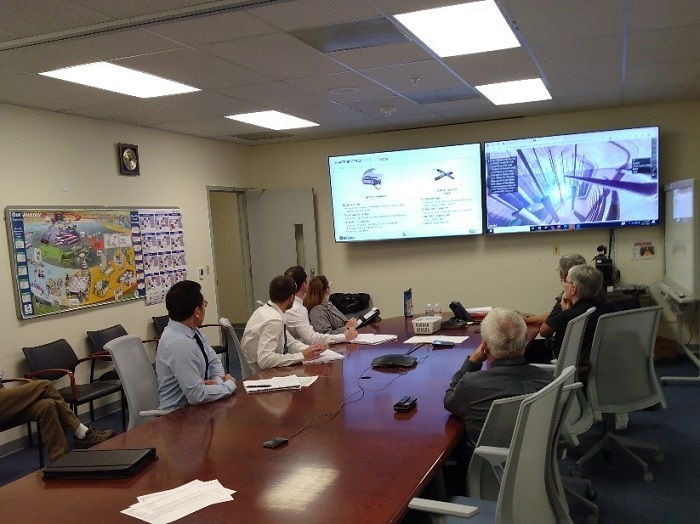 Engineers from the United Kingdom’s Sellafield Site discussed tank waste storage, retrieval and disposition with Washington River Protection Solutions engineers during a visit to the Hanford Site.
This international exchange underscores EM’s commitment to shared learning and expertise, reinforcing the global effort on safe and effective nuclear site cleanup.
During the visit, engineers from Sellafield met with workers from EM Hanford Site contractor Washington River Protection Solutions (WRPS) to discuss Hanford tank waste-retrieval operations, the recent dome-core cutting and riser installation and ongoing technology development efforts.
“WRPS was thrilled to host this visit from our counterparts in the U.K.,” said Mike Leonard, WRPS manager of Tank Farm Projects Engineering and Chief Technology Office. “We shared some of our collective experience and lessons learned, and Sellafield shared theirs with project planning for a multiphase approach to waste retrieval, treatment and disposition.”
The collaboration extended to Hanford contractor Central Plateau Cleanup Company, responsible for several risk-reduction projects, and teams shared information about remediating contaminated soil and transferring radioactive sludge in the K West Reactor near the Columbia River to storage further inland.
“On behalf of Sellafield, thanks very much to everyone for coordinating and hosting our visit,” remarked Tom McMillan, technical lead for Sellafield’s Site Ion Exchange Effluent Plant. “Learning from Hanford’s experience in retrieval operations will help inform the design of new storage vessels on the Sellafield Site, creating a different legacy for future generations.”
-Contributor: Derek Miceli
 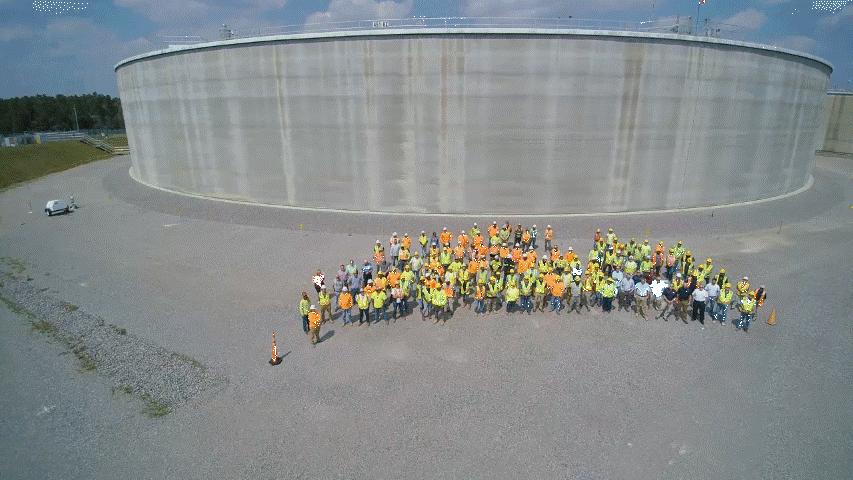 The Saltstone Disposal Unit (SDU) 8 project team, which includes Savannah River Mission Completion subcontractors and direct hires, stand in front of the newest mega-size SDU completed at the Savannah River Site.
EM recently awarded performance-based fees payments to 14 of its contractors at sites across the DOE complex, including Hanford, Savannah River, Oak Ridge, Paducah, Portsmouth, Nevada, Idaho, Los Alamos, Waste Isolation Pilot Plant and Savannah River National Laboratory.
The cleanup program releases information relating to contractor fee payments — earned by completing work called for in the contracts — to further transparency in its cleanup program.
Following are the fee payments for the contractors over varying performance evaluation periods:
- Washington River Protection Solutions, the Hanford Site Office of River Protection (ORP) tank operations contractor, was awarded nearly $38.5 million, or 82% of the available fee of more than $47 million for fiscal year 2023.
- ORP 222-S Laboratory contractor Hanford Laboratory Management and Integration received just over $3.4 million, or 74% of the available fee of almost $4.6 million for fiscal year 2023.
-
Savannah River Site (SRS) management-and-operations (M&O) contractor Savannah River Nuclear Solutions received over $27.9 million, or 96% of the available fee of nearly $29 million for fiscal year 2023.
- Savannah River Mission Completion, the liquid waste contractor at SRS, received more than $1.72 million, or nearly 99% of the available fee of nearly $1.74 for fiscal year 2023.
- Centerra-Savannah River Site, the protective force services contractor at SRS, was awarded more than $4.76 million, or 92% of the available fee of over $5.16 million for the period of Oct. 8, 2022, to July 14, 2023.
- At Savannah River National Laboratory, M&O contractor Battelle Savannah River Alliance earned nearly $5.9 million, or 97% of the available fee of almost $6.1 million for fiscal year 2023.
- UCOR, the Oak Ridge Office of Environmental Management cleanup contractor, was awarded nearly $29 million, or 94% of the available fee of about $31 million for fiscal year 2023.
- Four Rivers Nuclear Partnership, the Paducah Site cleanup contractor, received close to $8 million, or 92% of the available fee of nearly $8.7 million for fiscal year 2023.
- Fluor-BWXT Portsmouth, the Portsmouth Site decontamination and decommissioning contractor, was awarded about $11.5 million, or 97% of the available fee of more than $11.8 million for the period of March 29 to Sept. 30 this year.
- Mid-America Conversion Services earned about $6.7 million, or 61% of the available fee of approximately $11 million for fiscal year 2023, for its operation and maintenance of the depleted uranium hexafluoride (DUF6) conversion facilities at the Portsmouth and Paducah sites.
- Navarro Research and Engineering, EM’s cleanup contractor for the Nevada National Security Sites, was awarded close to $1.82 million, or 93% of the available fee of almost $1.96 million for fiscal year 2023.
- Idaho Environmental Coalition, EM’s cleanup contractor at the Idaho National Laboratory Site, received nearly $35.2 million, or 96% of the available fee of more than $36.8 million for fiscal year 2023.
- Newport News Nuclear BWXT-Los Alamos, the EM Los Alamos Field Office legacy cleanup contractor at the Los Alamos National Laboratory, earned more than $13.2 million, or 77% of the available fee of about $17.2 million during fiscal year 2023.
- Salado Isolation Mining Contractors, the M&O contractor for the Waste Isolation Pilot Plant, earned about $11.5 million, representing nearly 89% of the available fee of about $13 million for the period of Feb. 4 to Sept. 30 this year.
  EM Strategic Planner Robert ‘Buz’ Smith, far left, and Four Rivers Nuclear Partnership Community Outreach Coordinator Steve Christmas, far right, present a check for $500 to this year’s West Kentucky Regional Science Bowl T-Shirt Design Contest winners. From left: Smith, Heath Middle School Science Bowl Coach Brandy Roberts, contest winners Maximilian Steger and Andrew Byrne, and Christmas. Also pictured is the mascot for the Heath Middle School Pirates team.
EM’s Portsmouth/Paducah Project Office issued challenge to design t-shirt
PADUCAH, Ky. — The winners of this year’s DOE West Kentucky Regional Science Bowl T-shirt Design Contest celebrated “Making Breakthroughs” with their design.
Heath Middle School eighth graders Maximilian Steger and Andrew Byrne’s design will be printed on the official t-shirt given to all participating students and coaches to wear during competition. Heath Middle School received $500 for their successful efforts.
“Our kids pitch ideas for t-shirt designs during our first West Kentucky Regional Science Bowl team meetings, which is a great team building exercise,” Heath Middle School Science Bowl Coach Brandy Roberts said. “They put a lot of thought into the concepts and apply what we study to reinforce the message about science education.”
 The winning design by Heath Middle School eight graders Maximilian Steger and Andrew Byrne for the 2024 DOE West Kentucky Regional Science Bowl t-shirt.
Local middle and high school students were given the challenge to design a t-shirt for the annual competition by EM’s Portsmouth/Paducah Project Office. The West Kentucky Regional Science Bowl attracts dozens of schools and hundreds of regional students to compete for the opportunity to advance to the national level.
“The creativity from all the submissions this year was outstanding,” EM Paducah Site Lead April Ladd said. “This type of talent is an excellent example of the intersection of art and science.
The 2024 West Kentucky Regional Science Bowl will take place in February.
-Contributor: Dylan Nichols
 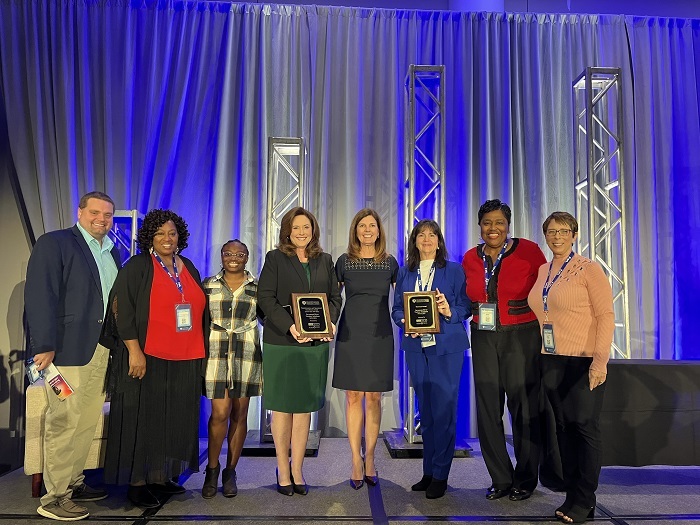 The Savannah River Nuclear Solutions Continuous Improvement Team accepts the Transformational and Operational Excellence Award from Lt. Gov. Pamela Evette on behalf of the governor and the state of South Carolina during the South Carolina Manufacturing Conference and Expo. From left: Blake Leaphart, Cynthia Boler-Melton, Tamia Smalls, Dawn Haygood, Evette, Barbara Smoak, P.K. Hightower and Lisa Steed.
AIKEN, S.C. — An EM contractor for the Savannah River Site (SRS) was recently awarded the Transformational and Operational Excellence Award at the South Carolina Manufacturing Conference and Expo for achievements in continuous improvement and operational excellence that generated over $42 million in cost savings during fiscal year 2023.
“This was a record year for SRS and continuous improvement,” said Perjetta “PK” Hightower, director of interface management and continuous improvement for Savannah River Nuclear Solutions (SRNS). “SRNS engaged nearly 17% of its workforce with over 180 continuous improvement initiatives, achieving over $42 million in savings — $22 million of which was hard-dollar savings to be used to increase work scope.”
The seventh annual event by the South Carolina Manufacturing Extension Partnership (SCMEP) brought over 200 companies from across the Southeast to the Greenville Convention Center. SCMEP is a nonprofit that connects manufacturing companies across South Carolina to benchmark best practices, training, Lean Six Sigma tools and continuous improvement initiatives. The Six Sigma methodologies identify opportunities for improvement within organizations by eliminating waste and increasing standardization.
“The continuous improvement team has partnered with SCMEP for nearly 15 years, so it is incredibly exciting to take home this award and to be one of the top manufacturing companies with over 500 employees,” said Lisa Steed, SRNS continuous improvement Lean Six Sigma specialist. “We will continue to transform both general employment activities and more specialized sitewide processes to be more efficient, cost effective and customer driven.”
The core continuous improvement team is comprised of certified Lean Six Sigma Black Belts and reinforced by divisional continuous improvement experts. SRS transformed many of its day-to-day operations by implementing the nationally recognized IDEAS (Individuals Developing Effective Alternative Solutions) Program for employee suggestions. In fiscal year 2023, over 250 implemented ideas streamlined various work processes and generated over $4.9 million in savings, an increase of over $1 million from the previous fiscal year.
“The final return on investment for the IDEAS Program for fiscal year 2023 was $88.63, meaning that for every dollar spent on the IDEAS Program, the return was $88.63 back to the company,” said Blake Leaphart, SRNS continuous improvement Lean Six Sigma specialist.
“These results are experienced by all — from the workers on the frontline to the senior management who report gains and savings to the Department of Energy,” Leaphart said. “We are incredibly proud of this accomplishment.”
In addition to the IDEAS program, SRS uses operational excellence to ensure the functional success of its continuous improvement programs and to identify areas of improvement. Operational excellence tools include causal analysis, corrective action program, self-assessment program, performance analysis and an independent evaluation board.
“We will continue to strategically transform business and operation management systems to keep pace with changing needs; facilitating renewal of the workforce, missions and infrastructure at SRS to provide increasing value for the nation and community,” Hightower said.
-Contributor: Mackenzie McNabb

The EM Update will not be published on Tuesday, Dec. 26 and Tuesday, Jan. 2. We will return to our regular publishing schedule on Tuesday, Jan. 9.
|